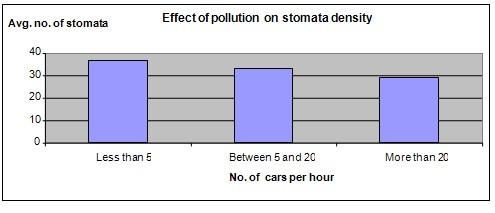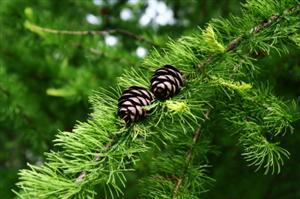| Complexity level: | 7 |
| Project cost ($): | 50 |
| Time required: | 1 hour to prepare, 3 days for observation |
| Material availability: | Easily obtained. Access to a microscope is required |
| Safety concerns: | Basic safety requirements |
Hypothesis
The stomata density in pine tree leaves taken from locations with a higher traffic flow is lower.
Overview
Stomata in plants
Stomata are tiny plant structures found on the epidermis of plants. They allow water vapor, carbon dioxide and oxygen to move in and out of a leaf. Most plants have stomata on the bottom side of the leaf. Each stomata consists of a tiny hole called a stoma, and 2 guard cells at the sides. The stoma opening allows for the diffusion of carbon dioxide and oxygen gases while the guard cells at the side serve to open or close the stoma. The stoma opens for carbon dioxide molecules to enter in order to enable photosynthesis to take place. However, when the weather gets too hot, the stoma closes to prevent loss of water.
The stomata provides a channel or opening for the plant to interact directly with its surrounding atmosphere. Diffusion of gasses in and out of the plants takes place through the holes in the stomata. Water molecules are also released into the air through the opening in the stoma. When water molecules escape from the surface of the leaf, hydrostatic pressure reduces. This causes the water and nutrients collected in the roots to be pulled upwards. This transpiration and flow of water also helps in cooling down plants. The amount of water lost by a plant will depend on the humidity, temperature, wind conditions and the amount of water in the soil.
Stomatal density is the number of stomata per square millimeter. It can range from 100 to 1000 stomata per square millimeter, depending on the type of plant and the environmental conditions during the plant’s development. Stomatal density will be greater if the plant develops in environments with greater amounts of light, lower atmospheric concentrations of carbon dioxide and in moist environments.
Scientific Terms
Materials
The materials required for this science fair project:
- 15 pine trees at locations with different concentrations of automobile traffic. For example, you could locate trees in the city, at the city fringe, and in the country. You should ensure that all the trees are of the same species
- 3 bottles of clear nail polish
- A roll of clear cellophane tape, 2cm wide
- 15 glass slides
- A microscope
- 15 plastic bags
- A black marker pen
- A car and a driver
- GPS (global positioning system) equipment, or a good map
Procedure
1. For this science fair project, the independent variable is the concentration of traffic at the location of the pine trees. The dependent variable is the number of stomata on the surface of their leaves. This is determined by viewing the leaf under a microscope and counting the number of stomata. The constants (control variables) are the size of the trees, the age of the leaves, the size of the leaves and the size of the tape.
2. 5 pine trees at each of 3 different locations are selected for this experiment. The pine trees should be about the same age and height. The concentration of traffic near the site of the trees is observed for 4 hours (ensuring that you include peak hour traffic) and the average number of vehicles that pass by the site, per hour, is recorded in the table below. At each of the 3 locations, perform your traffic counting during the same block of time. For example, if you choose to observe traffic between 2 to 6 pm, you should do so for all three locations.
3. Samples of 2 leave clusters from each of the 15 pine trees are collected. The leaves collected from each tree should be about the same size and of the same level of maturity. The plastic bags are labeled according to the location of the trees and the leaf samples are placed in a bag. The leaves are brought back to the lab.
4. Place the individual pine leaves immediately adjacent to each other. Using the transparent nail polish, a 2cm x 2cm area is painted on the bottom of each leaf (pick the a dense part of the leaf cluster) . The nail polish is left to dry and a piece of cellophane tape is placed over the nail polish. Peel off the cellophane tape and the skin of the leaf will come off with the cellophane tape. The tape is placed over a glass slide and viewed under a microscope. Count the number of stomata viewed under the microscope.
5. The average number of stomata for the leaves from each pine tree is calculated and recorded and the results are shown in the table below.

Results
It is observed that the greater the concentration of traffic where the sample leaves are collected, the lesser the amount of stomata found on the sample leaves.
| Number of cars per hour | Less than 5 | Between 5 and 20 | More than 20 |
| Average number of stomata | 37 | 33 | 29 |
The graph below represents the results of our science experiment.

Conclusion
The hypothesis that the stomata density of pine tree leaves taken from trees found in locations with a higher concentration of traffic will be lower, is correct.
Heavier traffic flow will result in a higher level of pollution and higher levels of emissions of carbon dioxide. The presence of more carbon dioxide may stimulate plant growth. But the plant will also require more nutrients, sunlight and water for the growth to be accelerated. Unless these resources are readily available, the plant will need less stoma.
Also consider
Try to repeat this science fair project by taking leaf samples from different types of trees.
References
Plant transpiration - http://www.juliantrubin.com/encyclopedia/botany/transpiration.html
Stoma - http://en.wikipedia.org/wiki/Stoma
Carbon dioxide and plant response - http://www.concord.org/~btinker/gaiamatters/investigations/stomata.html

